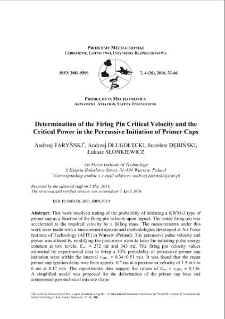Our Digital Library contains 1 868 digital objects
Object
Title: Determination of the Firing Pin Critical Velocity and the Critical Power in the Percussive Initiation of Primer Caps
Alternative title:
Wyznaczanie krytycznej prędkości iglicy i mocy krytycznej przy uderzeniowym pobudzaniu spłonki
Contributor:
Andrzej DŁUGOŁĘCKI, Jarosław DĘBIŃSKI,Łukasz SŁONKIEWICZ
Abstract:
This work involved testing of the probability of initiating a KWM-3 type of primer cap as a function of the firing pin velocity upon impact. The tested firing pin was accelerated to the required velocity by a falling mass. The measurements under this work were made with a measurement system and methodologies developed at Air Force Institute of Technology (AFIT) in Warsaw (Poland). The percussive pulse velocity and power was altered by modifying the percussive mass to keep the initiating pulse energy constant at two levels: Ewe = 272 mJ and 343 mJ. The firing pin velocity values estimated by experimental data to bring a 50% probability of percussive primer cap initiation were within the interval vi50% = 0.34÷0.51 m/s. It was found that the mean primer cap ignition delay rose from approx. 0.7 ms at a percussion velocity of 1.5 m/s to 6 ms at 0.17 m/s. The experimental data suggest the values of Ewe x vi50% = 0.136. A simplified model was proposed for the deformation of the primer cap base and compressed pyrotechnical mixture shape. The model served to determine the approximate time trend for the penetration of the primer cap by the firing pin, including velocity, power and emitted energy, by assuming a complete energy transfer from the percussive mass to the primer cap. The average time initiating pulse power calculated from the model at the vi50% was Pavg = 120÷180 W, whereas the maximum initiating pulse power was Pmax = 170÷250 W. The calculated time values for firing pin penetration were very close to the aforementioned primer cap ignition delays at the respective velocity and percussive mass values. This indirectly indicates nearly complete energy transmission from the percussive masses to the primer caps. A location was identified within the compressed pyrotechnical mixture shape volume which could form the hot spot for initiation of the explosive reaction. Based on the calculation results using the simplified model, and assuming that the speed energy transfer to – and diffusive heat flux output from – the explosive reaction initiation hot spot were equivalent, the expression of Ewe vi50% derived from the result was approx. 0.18. This means that the two critical parameters of primer cap initiation: velocity, which can be identified with vi50% (and the respective power) and Ewe50%, i.e. the energy threshold below which the probability of primer cap initiation is less than 0.5, are interrelated. Aside from the initiation mechanism proposed and applied to calculate the firing pin critical velocity, this work discusses several other initiation mechanisms, all of which were ruled out during the testing process.
Place of publishing:
Warszawa
Publisher:
Date created:
Date submitted:
Date accepted:
Date issued:
Extent:
Identifier:
oai:ribes-88.man.poznan.pl:2294
Call number:
Electronic ISSN:
Print ISSN:
Language:
Rights holder:
Starting page:
Ending page:
Volume:
Keywords:
mechanics, percussive primer cap initiation, critical power, time delay, ignition probability
Object collections:
Last modified:
Jul 24, 2025
In our library since:
Jul 24, 2025
Number of object content hits:
0
All available object's versions:
https://ribes-88.man.poznan.pl/publication/2594
Show description in RDF format:
Show description in OAI-PMH format:
| Edition name | Date |
|---|---|
| Determination of the Firing Pin Critical Velocity and the Critical Power in the Percussive Initiation of Primer Caps | Jul 24, 2025 |
Objects Similar
Andrzej M. FARYŃSKI Tomasz BRODNIEWICZ2, Jarosław DĘBIŃSKI, Łukasz SŁONKIEWICZ, Radosław SZYMAŃSKI, Zbigniew ZIÓŁKOWSKI

